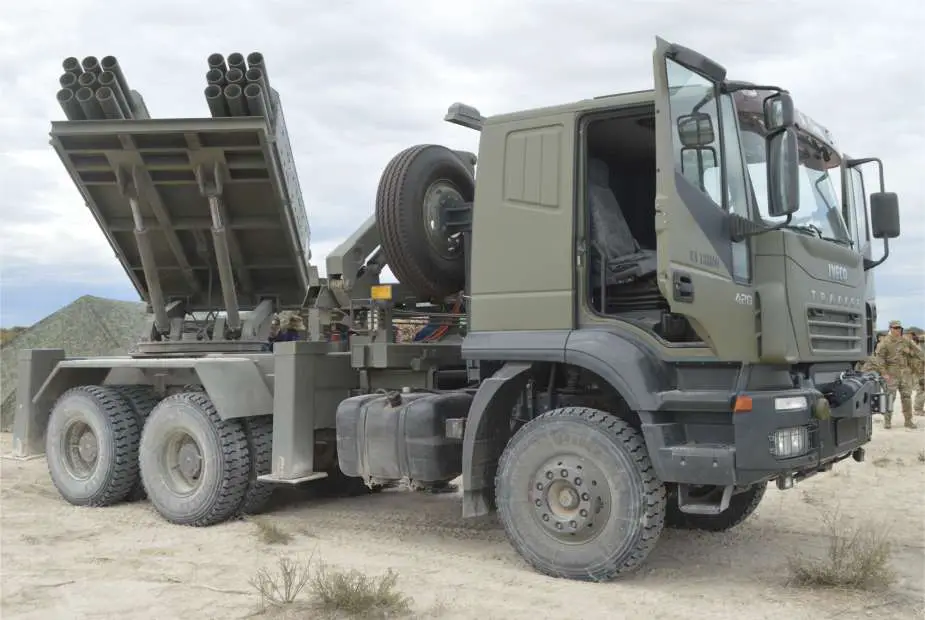Breaking news
Argentina tests CP-30 Multiple Launch Rocket System with Pampero 105 mm rockets.
The Argentine Army tested the CP-30 Multiple Launch Rocket System (MLRS) with Pampero rockets during the Escuela de Fuego II exercise at Salinas del Bebedero, San Luis. This system, conceived and developed in Argentina by the Scientific and Technical Research Institute for Defense (CITEDEF) and manufactured by Fabricaciones Militares, has been in service since 2012. Normally equipped with 127 mm rockets, the CP-30 this time used 105 mm Pampero rockets, demonstrating significant operational flexibility.
Follow Army Recognition on Google News at this link

The Argentine Army tested the CP-30 Multiple Launch Rocket System (MLRS) with Pampero rockets during the Escuela de Fuego II exercise. (Picture source: X account of Facundo)
The CP-30 is noted for its ability to launch rockets of various calibers, including 127 mm rockets for medium and long-range strikes and now 105 mm Pampero rockets for short-range missions. It features three modules, each containing nine launcher tubes for 127 mm rockets, and can be reconfigured to accommodate up to 54 tubes for 105 mm rockets. This modular capability increases the versatility of the CP-30, allowing the military to select the most suitable armament for the mission.
The CP-30's guidance system incorporates advanced technologies such as GPS, a magnetic compass, and a portable weather station, ensuring high precision in rocket launching. With a firing rate of one rocket every 0.5 seconds and a weight of up to 17 tons when loaded, the CP-30 can carry out rapid and effective strikes over a maximum distance of 30 km with 127 mm rockets and 10 km with 105 mm rockets.
Development of the CP-30 began in 2007 within CITEDEF's propulsion department, marking the start of an intense development period that lasted four years. This design and development phase aimed to create a rocket launch system that combines technological innovation and operational efficiency. In 2010, the Argentine Army conducted the first test firings of the CP-30, confirming its potential as a cutting-edge artillery system.
The Argentine Army officially adopted the CP-30 in December 2012, establishing the Grupo de Artillería de Sistemas de Lanzadores Múltiples 601 (GALM 601) and highlighting the strategic importance of the system to the Argentine armed forces. The production of the CP-30 began shortly before its service entry, marking a significant step in enhancing Argentina's defense capabilities.
The CP-30 is characterized by its ability to launch rockets of different calibers, mainly 127 mm rockets and 105 mm Pampero rockets, thus offering great flexibility in its use. It is equipped with a state-of-the-art guidance system that includes GPS, a magnetic compass, and a portable weather station, allowing for precise strikes on targets up to 30 km away with 127 mm rockets and 10 km with 105 mm rockets.
The design of the CP-30 also emphasizes mobility and rapid deployment. Mounted on Fiat 697N or Iveco Trakker 6x6 trucks, the system can be quickly moved and prepared for launch, minimizing the risk of enemy counterattack. This ability to rapidly reposition, combined with a high rate of fire, makes the CP-30 a valuable tool for the Argentine Army, capable of effectively meeting the demands of modern military operations.
The Argentine Army continues to innovate by developing new projectiles like the MU-GAP, a precision-guided projectile under development by CITEDEF, which could be launched by systems such as the CP-30. International interest in the CP-30 was highlighted by the visit of the Bolivian Minister of Defense in 2015, indicating potential for export sales.
This demonstration during the Escuela de Fuego II exercise highlights the capabilities of the CP-30 and its central role in the modernization of Argentine artillery, offering an adaptable and powerful platform for various combat missions.

























